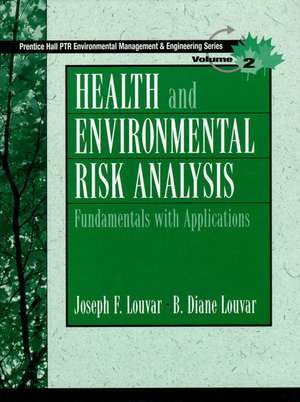Health and Environmental Risk Analysis: Fundamentals with Applications
Autor Joseph F. Louvar, B. Diane Louvaren Limba Engleză Hardback – 9 noi 1997
Introduces the fundamentals and applications of health and environmental risk analysis. This is a subject which continues to grow in importance especially in light of the increasing awareness among governments, corporations, and communities to their responsibilities to society.
Preț: 415.26 lei
Preț vechi: 451.37 lei
-8% Nou
Puncte Express: 623
Preț estimativ în valută:
79.46€ • 86.58$ • 66.96£
79.46€ • 86.58$ • 66.96£
Disponibilitate incertă
Doresc să fiu notificat când acest titlu va fi disponibil:
Se trimite...
Preluare comenzi: 021 569.72.76
Specificații
ISBN-13: 9780131277397
ISBN-10: 0131277391
Pagini: 704
Dimensiuni: 178 x 235 x 32 mm
Greutate: 1.18 kg
Ediția:1
Editura: Pearson Education
Colecția Prentice Hall
Locul publicării:Upper Saddle River, United States
ISBN-10: 0131277391
Pagini: 704
Dimensiuni: 178 x 235 x 32 mm
Greutate: 1.18 kg
Ediția:1
Editura: Pearson Education
Colecția Prentice Hall
Locul publicării:Upper Saddle River, United States
Cuprins
1. Introduction.
2. Process Descriptions.
3. Hazard Identification.
4. Source Models.
5. Fault Tree Analysis.
6. Consequence Analysis.
7. Exposure Assessment.
8. Dose Response and Risk Characterization.
9. Radiation Risk Assessment.
10. Environmental Assessment.
11. Structural Activity Relationships.
12. Risk Management.
13. Managing Risk.
14. Regulations.
15. ISO 14000
Appendices.
Index.
Textul de pe ultima copertă
12773-8
The complete, up-to-date guide to quantifying and mitigating environmental risks. This book constitutes Volume 2 of the Prentice Hall PTR Environmental Management Engineering Series.
In an era of limited resources and heightened environmental awareness, professionals responsible for handling chemicals and chemical wastes need a deep understanding of quantitative risk analysis. This is the first book to assemble in-depth coverage of the diverse topics relevant to measuring and mitigating environmental risks.
A companion to the well-received Chemical Process Safety: Fundamentals with Applications, this book's readable explanations and illuminating case studies will help you:
- Identify potential hazards caused by process technology, human behavior, or lack of management systems
- Utilize EPA-compliant source models to describe and quantify release scenarios
- Create fault trees that use basic probability theory to analyze the likelihood of a release
- Quantify the potential consequences of a chemical release
- Understand the concepts and applicability of structural activity relationships (SARs) for identifying the hazards of chemicals
If you can measure a process, you can understand it, control it, and make it environmentally friendlier. Whether you are a professional safety, health, environmental or R&D professional—in industry, government, or the community—this book delivers all the tools you'll need.
Caracteristici
- Covers all fundamental concepts of risk analysis. Pg.___
- Unifies risk analysis concepts with Process Safety Management (OSHA) and Risk Management (EPA) regulations, and the International Organization of Standards' (ISO 14000) environmental management standard. Pg.___
- Progresses systematically from elementary concepts to advanced technology and techniques of risk analysis. Pg.___
- Covers various methods for calculating and reducing risks. Pg.___
- Presents many examples and illustrations. Pg.___
- Provides a companion to Chemical Process Safety: Fundamentals with Applications by Crowl & Louvar. Pg.___
- Includes references for additional information on risk analysis. Pg.___
